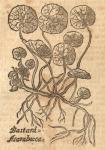
 I. The Names. It is called in Greek Ασαρον αγρίον: in Latin, Asarina, Asarum Sylvestre : in English, Bastard or Wild Asarabacca.
I. The Names. It is called in Greek Ασαρον αγρίον: in Latin, Asarina, Asarum Sylvestre : in English, Bastard or Wild Asarabacca.
II. The Kinds. It is the second Species mentioned in Chap 33. Sect. 2. aforegoing; and a singular Herb of the sort.
III. The Description. It has Roots long and slender, creeping under the upper crust of the Earth, and not shooting deep down, having a somewhat sharp taste, and a little bitter withal; from whence spring forth Leaves, almost like to our Garden Asarabacca, but somewhat rounder, and rougher than they, slightly and unevenly indented about the edges, growing upon long slender hairy Foot-stalks, yet is it but a low plant, and creeping, as it were, upon the Ground. The Flowers grow near unto the Ground, like unto those of Cammomil, but much lesser, and wholly Yellow, as well the border of the Leaves, as the Thrum; but Gerard says, they are of a Mealy or Dusty Colour, and not unpleasant in Smell. This Plant Clusius thinks to be his Tussilago Alpina secunda; but Parkinson says, that by reason of its sharp Taste, and creeping Root, it may more probably be taken to be the Cotyledon palustris acris, vel, Urens.
 IV. The Places. It is found, as Matthiolus (Pietro Andrea Mattioli d. 1577. -Maggie Meister) says, on the Mountains in Bohemia : and our Lobel [Matthias de L'Obel d. 1616] found it in several places in Somersetshire ; it delights in Woody and Shadowy places.
IV. The Places. It is found, as Matthiolus (Pietro Andrea Mattioli d. 1577. -Maggie Meister) says, on the Mountains in Bohemia : and our Lobel [Matthias de L'Obel d. 1616] found it in several places in Somersetshire ; it delights in Woody and Shadowy places.
V. The Times. It Flowers in May and June; and the Seed is brought to its ripeness much about Midsummer.
VI. The Qualities. It is hot and dry in the beginning of the third Degree: It Incides, Attenuates, and is Aperitive, and Cathartic: Appropriated to the Head, Stomach, Liver, Womb, and Joints.
VII. The Specification. I cannot yet find either from Authors, or my own Experience, what Disease it is peculiarly good for; but 'tis certain, 'tis a good Deoppilative, or opener of Obstructions.
VIII. The Preparations. You may have from it,
1. The green herb it self.
2. A Pouder of the same.
3. The Juice.
4. An Essence.
5. A Saline Tincture.
6. A Syrup of the Juice, or Herb.
7. A decoction.
The Virtues.
IX. The Green Herb. A little of it eaten with other Herbs, as a Salad, opens and loosens the Belly, and purges our Cold, Gross, Thick, Flegmatick Humors.
X. The Pouder. It may be given to 1 dram in Mead, Canary, Sherry, Malaga, or White Florence Wine, and so it will loosen the Belly, and purge thence Tough Thick Phlegm, and Black or Burnt Humors.
XI. The Juice. It has a Cleansing, Attenuating Quality; makes thin that which is thick, cuts that which is tough and breaks that which is hard, opens the Bowels which are obstructed, and purges out the Morbifick Matter of many grievous Disaffections, and therefore is profitably given to such as are afflicted with the Palsie, Falling-sickness, or Yellow Jaundice: It may be given from 2 drams to 3 or 4 drams according as the Patient is in Age and Strength, in a Glass of Mead or Wine.
XII. The Essence. It has the Virtues of the Juice, but is more grateful to the Stomach, and may be given to half an ounce, or more, in a Glass of Wine: It prevails against the Gravel (stones. -Maggie Meister) in Reins (kidney. -Maggie Meister) and Bladder; and gives Ease in the Gout, inwardly taken, and outwardly applied; and withal it kills Worms in Children.
XIII. The Saline Tincture. It opens Obstructions of the Womb, Reins and Bladder, provokes Urine, and expels Sand, Gravel, and Tartarous Slime: it kills Worms in old or young, and is profitable against the Dropsy (Edema. -Maggie Meister). Dose from j. dram to ij. in a Glass of White, or Rhenish Wine and Sugar.
XIV. The Syrup of the Juice or Herb. It has all the Virtues of the Juice, but must be given in full the double quantity, and is much better for Queasy Stomachs, and Children, than either the Juice or Essence; but it ought to be made in a Bath, for boiling will cause much of its Virtue to be lost.
XV. The Decoction. If it is made in Wine, it is a good Cephalick, and excellent against most cold Diseases of the Head, Brain and Nerves: Used as an Erhine, it purges the Head of cold and gross Humors: and taken inwardly from 2 to 4 ounces or more, it prevails against Epilepsies, Apoplexies, Lethargies, Vertigo, Megrim, Head-ache, Palsies, Convulsions, &c.
Botanologia, or The English Herbal, was written by William Salmon, M.D., in 1710.
This chapter has been proofread by Maggie Meister.

